For many PC builders, the chassis is more than just a box for components; it’s a statement piece, a reflection of personality, and the centerpiece of a setup. While standard black towers serve a functional purpose, the world of unique PC cases offers an opportunity to build a machine that’s truly distinctive. These enclosures defy conventional design, featuring unconventional shapes, materials, and layouts that push the boundaries of PC aesthetics.
This guide provides a purely informational, objective overview of some of the most unique PC cases available. We’ll explore their technical specifications, design philosophies, and the specific types of builds they are best suited for, helping you understand the landscape of unconventional chassis design. Whether you’re a seasoned enthusiast looking for a challenge or a builder aiming for a one-of-a-kind look, this analysis will provide the necessary details. For those just starting, understanding the fundamental types of PC cases is a great first step.
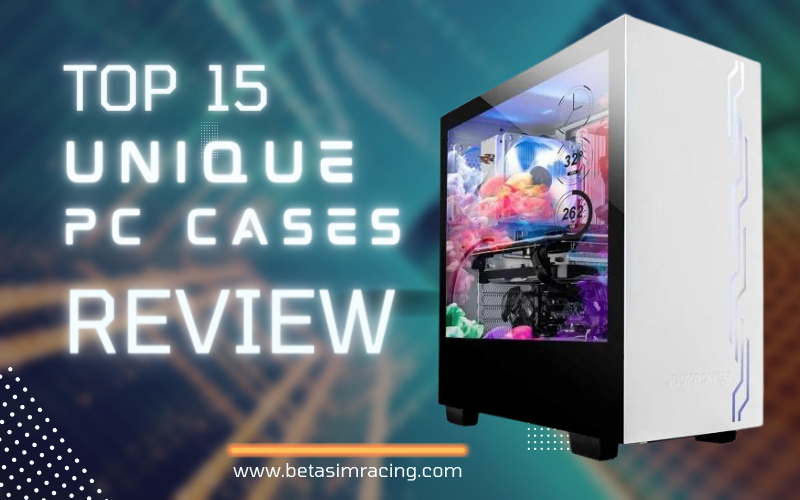
Comparison of 2025’s Most Unique PC Cases
This table provides a high-level overview of the key specifications for each featured case. Note that due to the highly unconventional nature of these designs, some standard metrics may not apply universally.
| Model | Case Type | Motherboard Support | Max GPU Length | Primary Material(s) | Dimensions (L×W×H) | Fan Support (Max) | Radiator Support (Max) | Drive Bays (3.5″/2.5″) |
| Corsair SPEC-DELTA RGB | Mid-Tower | ATX, Micro-ATX, Mini-ITX | 330 mm | Steel, Tempered Glass | 440 x 210 x 450 mm | 6x 120mm | 360mm | 2 / 2 |
| Thermaltake Core P3 TG Pro | Mid-Tower | E-ATX, ATX, Micro-ATX, Mini-ITX | 450 mm | Steel, Tempered Glass | 500 x 268 x 535 mm | 6x 120mm | 420mm | 4 / 5 |
| Thermaltake Versa N27 | Mid-Tower | ATX, Micro-ATX, Mini-ITX | 360 mm | Steel, Plastic | 463 x 197 x 490 mm | 5x 120mm | 240mm | 3 / 4 |
| iBUYPOWER Snowblind S | Mid-Tower | ATX, Micro-ATX, Mini-ITX | 420 mm | Steel, LCD Panel | 435 x 215 x 460 mm | 5x 120mm | 280mm | 2 / 2 |
| Thermaltake AH T200 | Micro-ATX | Micro-ATX, Mini-ITX | 320 mm | Steel, Tempered Glass | 551 x 282 x 422 mm | 4x 140mm | 280mm | 0 / 3 |
| Antec Dark Cube | Micro-ATX | Micro-ATX, Mini-ITX | 330 mm | Aluminum, Steel | 512 x 240 x 406 mm | 7x 120mm | 240mm | 1 / 1 |
| Antec Torque | Mid-Tower | E-ATX, ATX, Micro-ATX, Mini-ITX | 450 mm | Aluminum, Tempered Glass | 621 x 285 x 644 mm | 6x 120mm | 360mm | 1 / 1 |
| Anidees AI Crystal Cube | Mid-Tower | E-ATX, ATX, Micro-ATX, Mini-ITX | 335 mm | Steel, Tempered Glass | 435 x 308 x 380 mm | 8x 120mm | 280mm | 3 / 6 |
| Cougar CONQUER | Mid-Tower | ATX, Micro-ATX, Mini-ITX | 350 mm | Aluminum, Tempered Glass | 585 x 255 x 685 mm | 5x 120mm | 360mm | 2 / 4 |
| Cougar Conquer 2 | Full-Tower | E-ATX, ATX, Micro-ATX, Mini-ITX | 400 mm | Aluminum, Tempered Glass | 744 x 368 x 631 mm | 5x 120mm | 360mm | 2 / 2 |
| AZZA Pyramid 804L | Full-Tower | E-ATX, ATX, Micro-ATX, Mini-ITX | 330 mm | Aluminum, Tempered Glass | 632 x 490 x 490 mm | 3x 120mm | 360mm | 1 / 3 |
| InWin D-Frame 2.0 | Full-Tower | E-ATX, ATX, Micro-ATX | 415 mm | Steel, Aluminum, TG | 726 x 264 x 548 mm | 5x 120mm | 360mm | 0 / 4 |
| SilverStone SUGO 16 | Mini-ITX | Mini-ITX, Mini-DTX | 330 mm | Steel | 280 x 200 x 232 mm | 1x 120mm | 120mm | 1 / 1 |
| Unbranded “Tank” Case | Varies | Typically ATX | Varies | Steel, Aluminum, Acrylic | Varies | Varies | Varies | Varies |
| FSP T-WINGS CMT710 | Mid-Tower | E-ATX, ATX | 380 mm | Aluminum, Tempered Glass | 652 x 503 x 615 mm | 4x 120mm | 360mm (x2) | 1 / 3 |
Detailed Analysis of 15 Unique PC Cases
1. CORSAIR Carbide Series SPEC-DELTA RGB
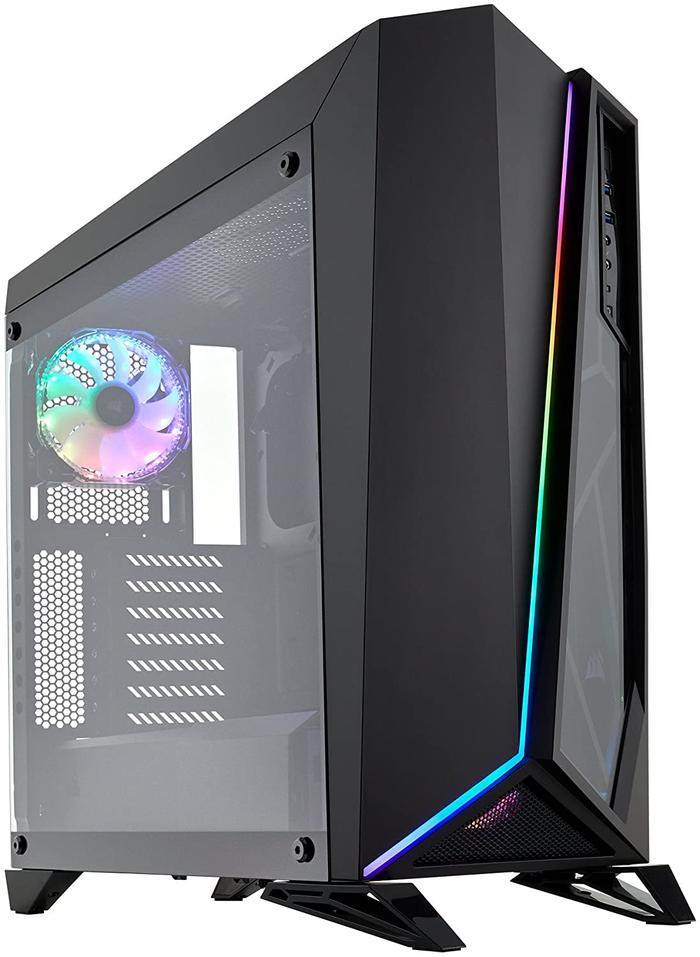
Design and Features
The CORSAIR Carbide Series SPEC-DELTA RGB stands out with its asymmetrical, angular front panel design. The dark, transparent accents on the fascia become visible only when the three pre-installed RGB fans are illuminated, creating a striking visual effect. It utilizes a fairly traditional mid-tower internal layout but wraps it in an aggressive, modern aesthetic.
- Form Factor: Mid-Tower
- Motherboard Support: ATX, Micro-ATX, Mini-ITX
- Material: Steel chassis with a full tempered glass side panel
- Cooling: Includes 3x 120mm RGB front fans and 1x 120mm rear fan. Supports up to a 360mm radiator in the front.
- Storage: Removable cage holds 2x 3.5″ HDDs, with an additional 2x 2.5″ SSD mounts.
Objective Analysis
The SPEC-DELTA RGB is a case for builders who want a unique aesthetic without straying into complex, open-air designs. Its internal layout is familiar and straightforward, making it accessible for builders of all skill levels. The primary draw is its front panel, which offers a more dynamic look than typical flat-front cases. However, the solid sections of the front panel mean it doesn’t offer the same level of intake as some of the best airflow PC cases. It represents a balance between unconventional looks and traditional functionality.
2. Thermaltake Core P3 TG Pro
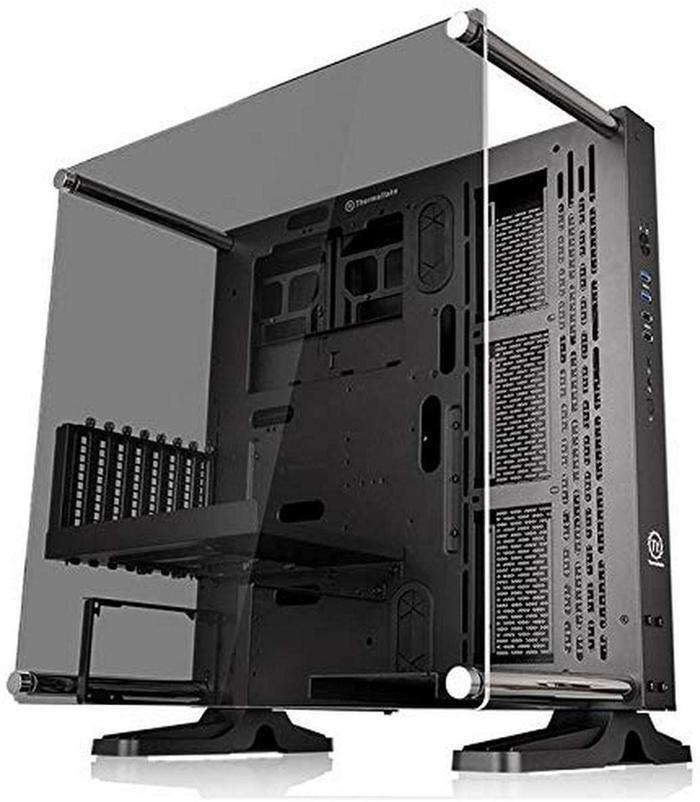
Design and Features
The Thermaltake Core P3 TG Pro is the evolution of the iconic open-frame chassis. Designed for maximum component visibility, it can be used in three different orientations: vertical, horizontal, or wall-mounted. It is essentially a flatbed for a motherboard and components, protected by a large 4mm thick tempered glass panel. This design is intended to showcase custom builds, particularly those featuring intricate water cooling setups.
- Form Factor: Mid-Tower (Open-Frame)
- Motherboard Support: E-ATX, ATX, Micro-ATX, Mini-ITX
- Material: SPCC Steel with a 4mm Tempered Glass Panel
- Cooling: Supports up to a 420mm radiator or distro plate on the side.
- Storage: Supports up to four 3.5″ HDDs or five 2.5″ SSDs with an optional bracket.
Objective Analysis
This case is specifically for enthusiasts who want their PC to be a work of art. The open-air design provides unparalleled access to components and eliminates airflow restrictions, but it also offers zero protection from dust and physical contact. The Core P3 TG Pro is less a case and more a canvas. Cable management and component selection are critical, as every element is on full display. It is an unsuitable choice for environments with pets, children, or high dust levels.
3. Thermaltake Versa N27 (Discontinued)
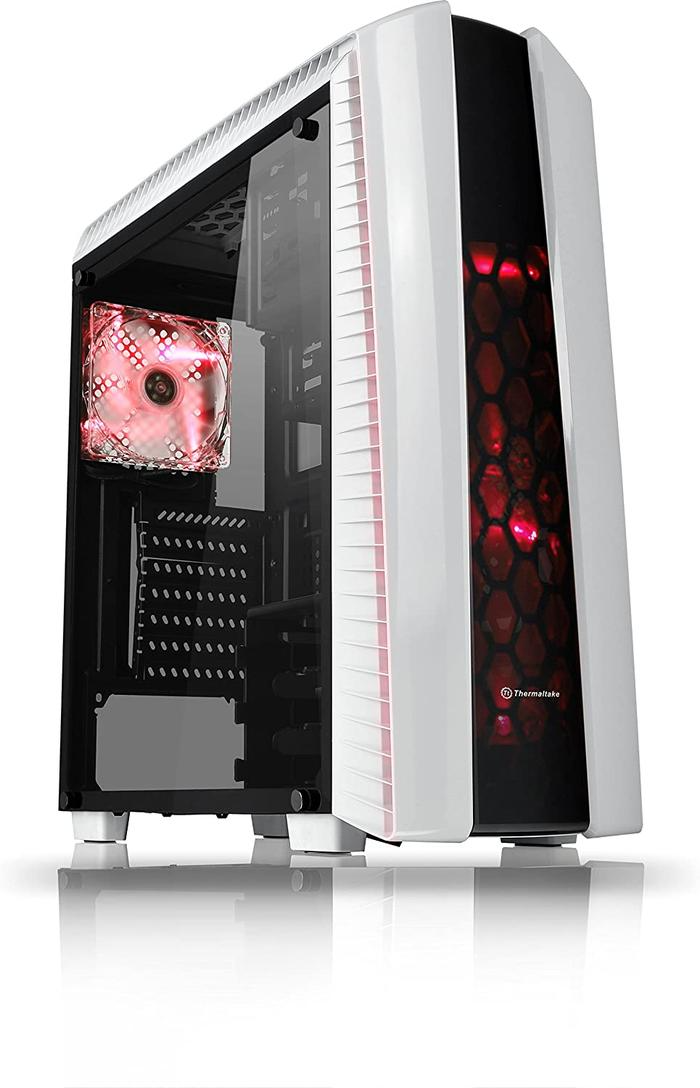
Design and Features
The Thermaltake Versa N27 was a mid-tower case featuring a “Shadow Blade” or “Arctic Blade” design on its front panel, which gave it a more aggressive, gamer-focused look than a standard chassis. It included a transparent side window (acrylic, not tempered glass) and tool-free drive bays, which were notable features at its price point upon release around 2017.
- Form Factor: Mid-Tower
- Motherboard Support: ATX, Micro-ATX, Mini-ITX
- Material: SPCC Steel with plastic front panel and acrylic window
- Cooling: Supported up to a 240mm radiator in the top and included one 120mm rear exhaust fan.
Objective Analysis & Current Alternative
The Versa N27 is discontinued and outdated by standards. Its use of acrylic, limited front I/O (USB 2.0), and more restrictive internal design are signs of its age. While it offered a unique look for its time, it has been surpassed by modern alternatives.
A suitable contemporary alternative is the Thermaltake Ceres 300 TG ARGB. It offers vastly superior airflow with a perforated metal front, includes modern I/O like USB Type-C, features a full tempered glass side panel, and provides much better support for current-generation cooling and oversized graphics cards.
4. iBUYPOWER Snowblind S
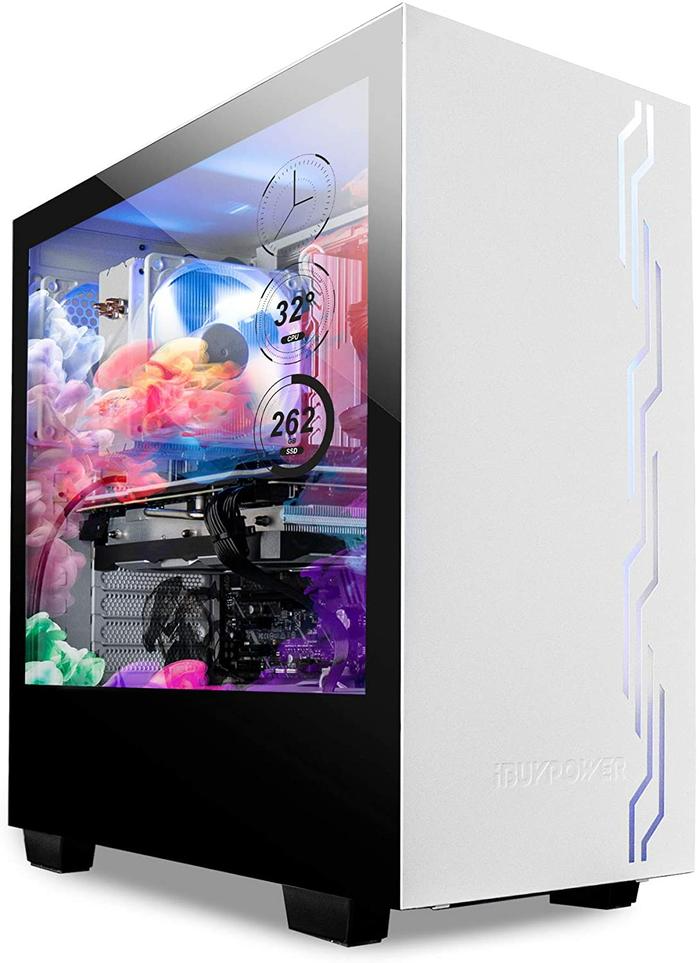
Design and Features
The iBUYPOWER Snowblind S is one of the most unique PC cases on the market due to its signature feature: a transparent 19-inch TN LCD side panel with a 1280×1024 resolution. This allows users to display animated wallpapers, system monitoring stats, or any visual content directly on the side of their PC, creating a dynamic, customizable display.
- Form Factor: Mid-Tower
- Motherboard Support: ATX, Micro-ATX, Mini-ITX
- Material: SECC Steel with a tempered glass front panel and LCD side panel.
- Display: 19” 1280×1024 TN LCD Side Panel
- Cooling: Supports up to a 280mm radiator in the front.
Objective Analysis
The Snowblind S is built around a single, powerful gimmick. The LCD panel is a true showstopper, but it comes with considerations. As a TN panel, viewing angles are limited, and achieving good visual contrast requires a brightly lit, all-white interior build. The case itself is a competent mid-tower, but the primary reason for its selection is the desire for a “living” side panel. It’s a specialized product for users who prioritize this novel form of customization above all else.
5. Thermaltake AH T200
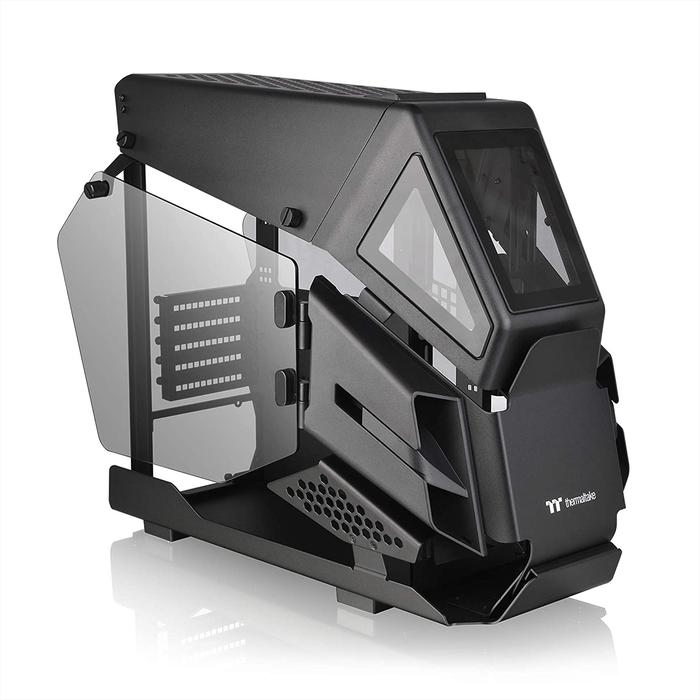
Design and Features
The Thermaltake AH T200 is a Micro-ATX case with a radical, open-frame design inspired by the aesthetics of an attack helicopter. Its chassis is constructed from steel and features five tempered glass panels on the front and sides, creating a cockpit-like view of the internal components.
- Form Factor: Micro-ATX (Open-Frame)
- Motherboard Support: Micro-ATX, Mini-ITX
- Material: Steel with 5x Tempered Glass panels
- Cooling: Supports up to a 280mm radiator in the front.
- Storage: Accommodates up to 3x 2.5” SSDs or 2x 3.5” HDDs (in the rear).
Objective Analysis
This case is a pure aesthetic choice for builders using the Micro-ATX vs Mini-ITX vs ATX smaller form factors. Its military-inspired design is aggressive and unmistakable. Like other open-frame designs, it offers excellent airflow potential but minimal protection from dust. The assembly process is more involved than a standard case due to its modular, multi-panel construction. It is ideal for a user building a themed PC who wants a compact yet visually loud statement piece.
6. Antec Dark Cube
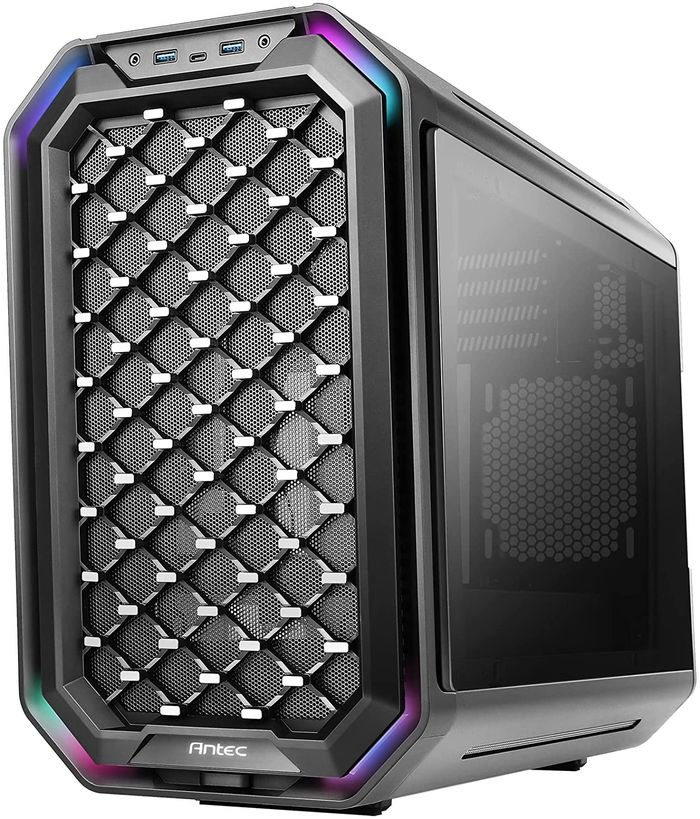
Design and Features
The Antec Dark Cube is a high-performance Micro-ATX case featuring a unique slide-open chassis design for easy access to components. It’s constructed from aerospace-grade aluminum panels, giving it a premium feel. The case is designed to be inverted, allowing for different hardware layouts and airflow configurations.
- Form Factor: Micro-ATX
- Motherboard Support: Micro-ATX, Mini-ITX
- Material: Aluminum, Steel
- Cooling: Supports a 240mm radiator in the front and a 120mm radiator in the rear.
- Storage: 1x 3.5″ HDD bay and 1x 2.5″ SSD bay.
Objective Analysis
The Antec Dark Cube combines a unique aesthetic with high-performance features. The slide-open mechanism is not just for show; it genuinely simplifies the building and upgrade process. Its aluminum construction and small footprint make it a premium choice for compact builds. However, its storage options are limited, making it best suited for builds that rely primarily on M.2 SSDs. For users wondering how many M.2 slots are on a motherboard, this case encourages maximizing them.
7. Antec Torque
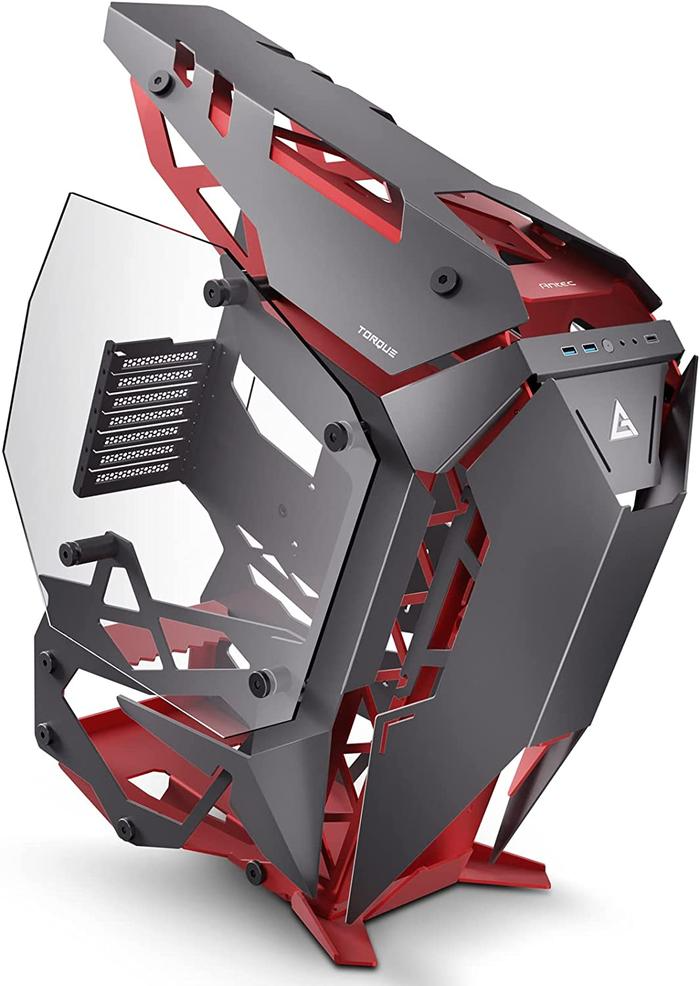
Design and Features
The Antec Torque is an open-frame chassis with a visually aggressive design composed of crimson and titanium-colored aluminum panels, all set at forward-leaning angles. It’s designed to look like it’s in motion. The case features dual 4mm tempered glass side panels to showcase the build within.
- Form Factor: Mid-Tower (Open-Frame)
- Motherboard Support: E-ATX, ATX, Micro-ATX, Mini-ITX
- Material: Aluminum, Tempered Glass
- Cooling: Supports 360mm radiators in both the front and top positions.
- Storage: 1x 3.5″ HDD bay and 1x 2.5″ SSD bay.
Objective Analysis
The Antec Torque is a “statement case” in every sense. Its primary function is to be visually stunning, and it’s built for custom water-cooling loops that can complement its complex angles. The build process is challenging and requires meticulous planning, especially for cable management. Like all open-frame cases, it is susceptible to dust. With minimal drive support, it’s intended for high-end gaming builds that prioritize speed and aesthetics over mass storage.
8. Anidees AI Crystal Cube AR V3
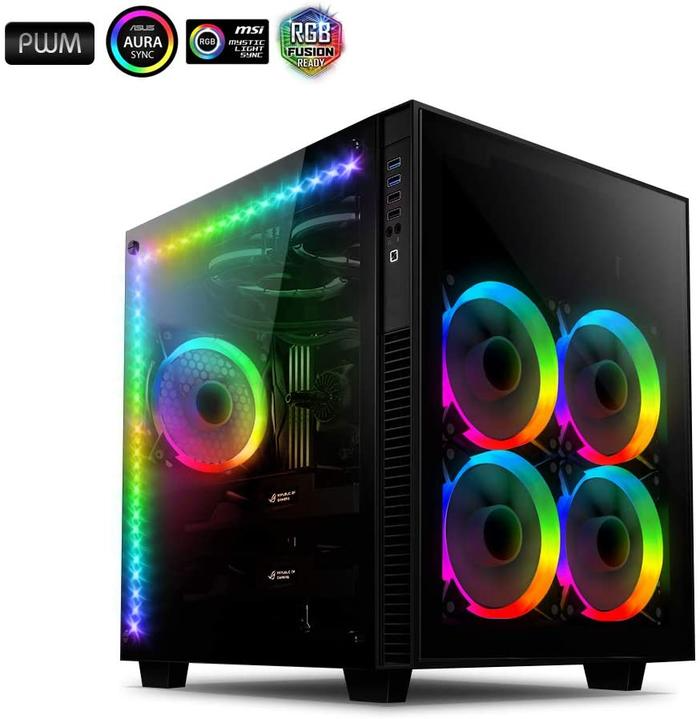
Design and Features
The Anidees AI Crystal Cube AR V3 is a dual-chamber cube case that puts components on full display through tempered glass panels on the front and both sides. The dual-chamber layout separates the main heat-producing components (motherboard, CPU, GPU) from the power supply and storage drives, which helps in creating a cleaner look and potentially improving thermal management.
- Form Factor: Mid-Tower (Cube)
- Motherboard Support: E-ATX, ATX, Micro-ATX, Mini-ITX
- Material: Steel, Tempered Glass
- Cooling: Supports up to two 280mm radiators. Comes with multiple pre-installed addressable RGB fans.
- Storage: 3x 3.5″ HDD bays and up to 6x 2.5″ SSD bays.
Objective Analysis
Cube-style cases offer a different building experience. The AI Crystal Cube provides a panoramic view of the hardware, making it excellent for RGB-heavy builds. The dual-chamber design simplifies cable management significantly, as all excess wiring can be hidden behind the motherboard tray. It offers excellent storage and cooling support for its size, making it a practical choice for builders who want a unique shape without the environmental drawbacks of an open-frame chassis.
9. Cougar CONQUER
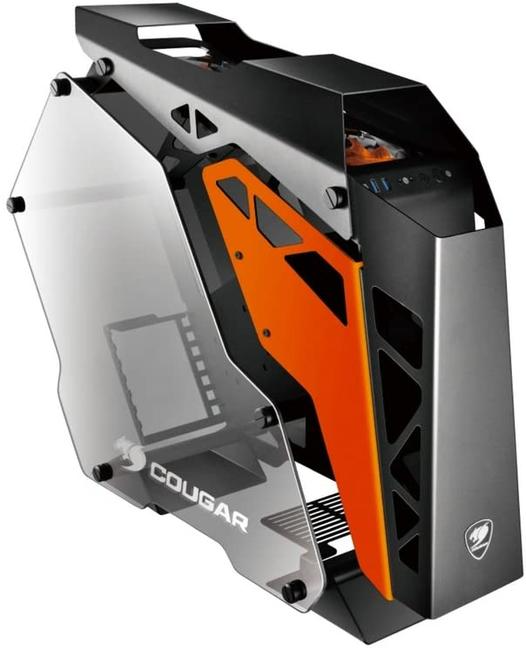
Design and Features
The original Cougar CONQUER is a landmark open-frame case that pioneered the “CNC-milled aluminum” aesthetic. It combines an aluminum frame with 5mm thick tempered glass side panels. Its design is based on a military-futuristic concept, with an exposed frame and a truss-like structure.
- Form Factor: Mid-Tower (Open-Frame)
- Motherboard Support: ATX, Micro-ATX, Mini-ITX
- Material: Aluminum, Tempered Glass
- Cooling: Supports a 360mm radiator in the top and a 240mm radiator in the front.
- Storage: 2x 3.5″ HDD bays and 4x 2.5″ SSD bays.
Objective Analysis
The Cougar CONQUER is an iconic case for enthusiasts. Its design is less about practicality and more about raw style. Building in it is an exercise in planning, as component choice and cable routing are highly visible and integral to the final look. While its successor, the Conquer 2, is larger and more modular, the original CONQUER is often preferred for its slightly more compact and focused design. It remains a relevant choice for custom loop builders aiming for a legendary aesthetic.
10. Cougar Conquer 2
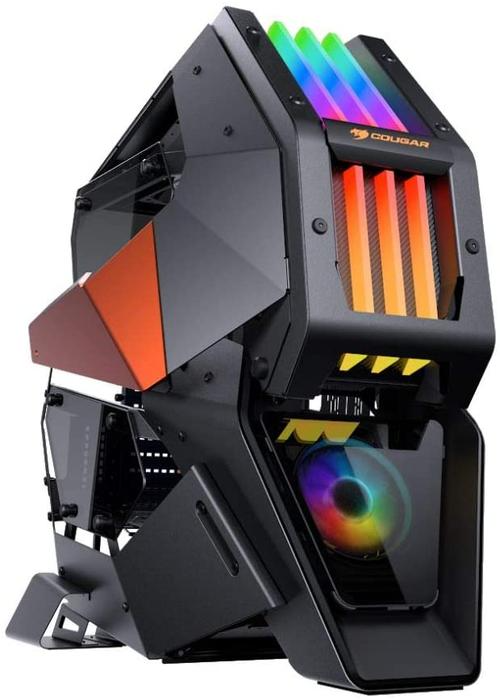
Design and Features
The Cougar Conquer 2 evolves the original’s design by introducing a unique “sub-chassis” concept. The internal chassis, which holds all the components, can be fully detached from the external metal frame. This dramatically simplifies the building process. The aesthetics are even more aggressive, with integrated RGB lighting and a more complex, layered look.
- Form Factor: Full-Tower (Open-Frame)
- Motherboard Support: E-ATX, ATX, Micro-ATX, Mini-ITX
- Material: Aluminum, Tempered Glass
- Cooling: Supports a 360mm radiator in the front and a 240mm radiator in the top.
- Storage: 2x 3.5″ HDD bays and 2x 2.5″ SSD bays.
Objective Analysis
The Conquer 2 addresses one of the main challenges of the original: the difficulty of building within a complex, fixed frame. The detachable sub-chassis is a genuinely innovative feature that improves user experience. However, this is a massive and heavy case, demanding significant desk space. Its bold, orange-and-black styling is not for everyone, but for those who resonate with its design, it offers a slightly more practical take on the extreme open-frame concept.
11. AZZA Pyramid 804L
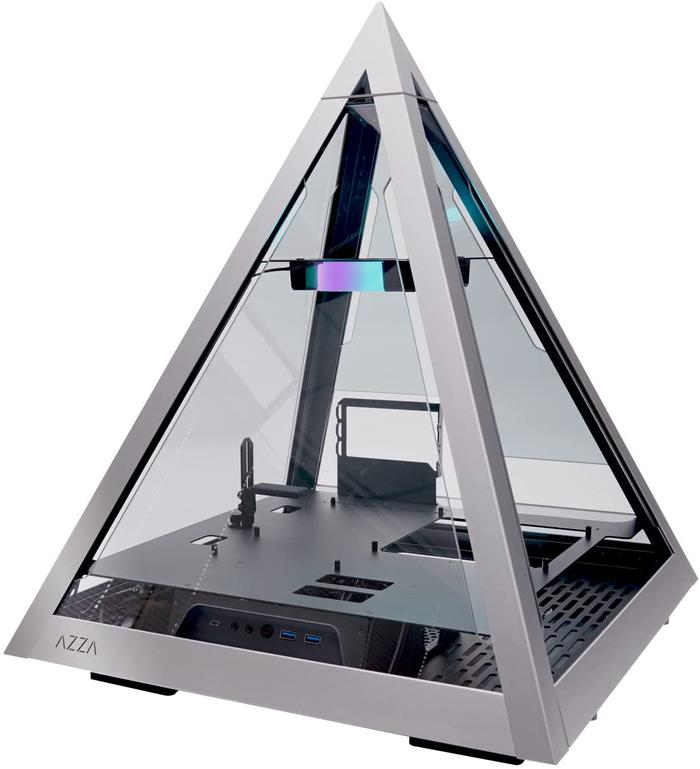
Design and Features
The AZZA Pyramid 804L is a stunningly unique case shaped like a four-sided pyramid, with tempered glass panels on all four sides. It’s designed to be a centerpiece, displaying hardware from every angle. The motherboard is mounted horizontally at the base, and a top-mounted 120mm fan exhausts heat upwards, following the natural principle of convection.
- Form Factor: Full-Tower (Pyramid)
- Motherboard Support: E-ATX, ATX, Micro-ATX, Mini-ITX
- Material: Aluminum, Steel, Tempered Glass
- Cooling: Supports up to a 360mm radiator in the base (by removing drive cages). Includes 1x 120mm Hurricane II ARGB fan at the top.
- Storage: 1x 3.5″ HDD bay and up to 3x 2.5″ SSD bays.
Objective Analysis
The Pyramid 804L is all about visual presentation. Building in it is unlike any other case and presents unique challenges, particularly with GPU mounting (which requires a PCIe riser cable) and radiator placement. Thermals can be a concern for very high-end components, as the intake airflow is limited. This case is for an experienced builder who wants to create a true conversation piece and is willing to plan their build meticulously around the chassis’s unique constraints.
12. InWin D-Frame 2.0
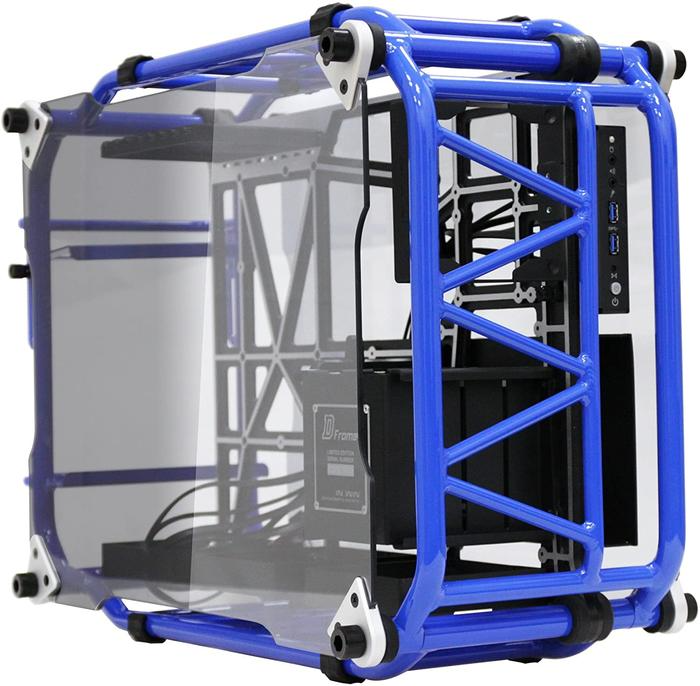
Design and Features
The InWin D-Frame 2.0 is a testament to craftsmanship, inspired by the trellis frame of a motorcycle. It is constructed from hand-welded steel tubes and features 5mm thick tempered glass side panels. This open-frame chassis is a “Signature” product from InWin, signifying its limited production and high-end focus. It even includes a dedicated 1065W power supply designed to match the case’s aesthetic.
- Form Factor: Full-Tower (Open-Frame)
- Motherboard Support: E-ATX, ATX, Micro-ATX
- Material: Steel tubes, Aluminum, Tempered Glass
- Cooling: Can support up to a 360mm radiator and five 120mm fans.
- Storage: 4x 2.5″/3.5″ combo bays.
Objective Analysis
The D-Frame 2.0 is a luxury item. Its cost, weight, and hand-crafted nature place it in a category of its own. It is extremely large and heavy, and its open design requires a clean environment. This is not a practical choice for most users; it is a functional sculpture for elite-tier builds where the budget is a secondary concern to achieving an unparalleled, industrial look. The included high-wattage PSU adds to its value proposition for builders using top-tier components like a high-end CPU for an RTX 3070 or even more powerful cards.
13. SilverStone SUGO 16
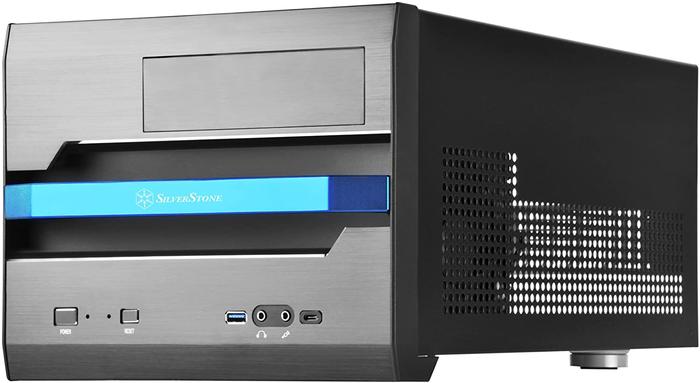
Design and Features
The SilverStone SUGO 16 is a unique take on the small form factor (SFF) cube case. This Mini-ITX chassis has a highly versatile design that allows for multiple orientations and component layouts. It can be set up to accommodate a large air cooler or a front-mounted AIO liquid cooler. The motherboard is installed in an inverted layout, and the case can even accommodate ATX power supplies.
- Form Factor: Mini-ITX (Cube)
- Motherboard Support: Mini-ITX, Mini-DTX
- Material: Steel
- Cooling: Supports a single 120mm fan/radiator in the front.
- Storage: 1x 3.5″ HDD bay and 1x 2.5″ SSD bay.
Objective Analysis
The SUGO 16’s uniqueness lies in its clever use of internal space. While externally it’s a simple, clean cube, its internal flexibility is remarkable for a case of only 13 liters. It allows builders to fit surprisingly powerful components into a very small footprint. This makes it an excellent choice for users who want a compact, minimalist PC without sacrificing too much performance. However, building in it requires careful component selection due to the tight clearances.
14. Unbranded “Tank” Style Cases (e.g., LIQIANG)
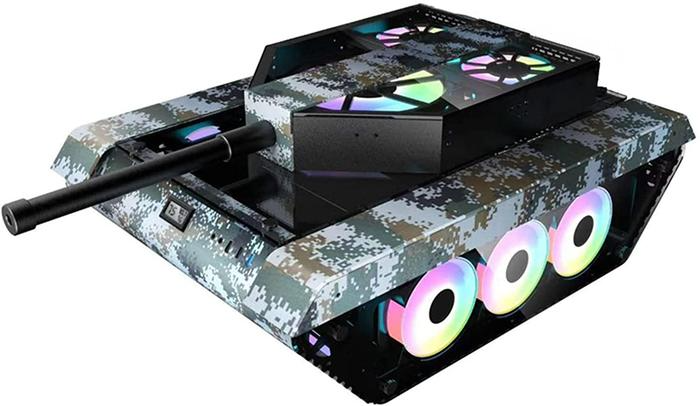
Design and Features
This category refers to a range of highly stylized, often unbranded PC cases sold on marketplaces like Alibaba and AliExpress under various names (like the “LIQIANG” mentioned in the source). They are frequently shaped like tanks, robots, or other sci-fi/military vehicles. These cases are almost always open-frame designs made from a mix of aluminum, steel, and acrylic panels.
- Form Factor: Varies (Often ATX)
- Material: Typically a mix of aluminum, steel, and acrylic.
- Features: Often requires full manual assembly from a kit of flat-packed parts. Focus is entirely on aesthetics.
Objective Analysis & Current Alternative
It is crucial to understand that these products are for hobbyists who enjoy the building process itself. Quality control, documentation, and customer support are non-existent. The materials can be flimsy, and assembly can be complex and frustrating.
For builders who want a verified, high-quality product with a similarly aggressive and deconstructed aesthetic, the Antec Torque or the Cougar Blazer are far superior alternatives. They offer a similar “weird” look but are backed by a reputable manufacturer, proper documentation, and standardized component compatibility.
15. FSP T-WINGS CMT710
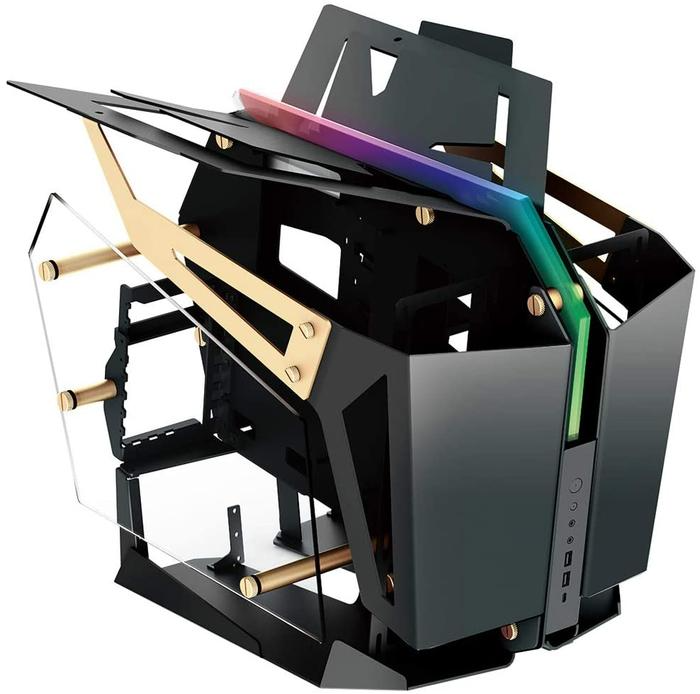
Design and Features
The FSP T-WINGS CMT710 is an exotic semi-open-air chassis that is uniquely capable of housing two complete PC systems in one unit. Its “T-Wing” design features two separate compartments, each with its own tempered glass side panel, joined by a central aluminum frame. The main side supports a full E-ATX build, while the secondary side can house a Mini-ITX system.
- Form Factor: Mid-Tower (Dual System)
- Motherboard Support: System 1: E-ATX; System 2: Mini-ITX
- Material: Aluminum, Steel, Tempered Glass
- Cooling: Supports dual 360mm radiators, one for each system.
- Storage: 1x 3.5″ HDD bay and 3x 2.5″ SSD bays.
Objective Analysis
The T-WINGS is a niche product designed specifically for two use cases: two-person gaming setups in a single chassis, or for streamers who want to run a dedicated gaming PC and a dedicated streaming PC in one enclosure. The design is visually striking and makes a powerful statement. Cable management is complex due to the dual-system nature, but the end result can be incredibly clean and impressive. It’s an innovative solution for a very specific audience.
Key Considerations for Selecting a Unique PC Case
Choosing an unconventional case requires more than just picking a design. The unique forms introduce practical considerations that must be addressed.
Form Factor and Hardware Compatibility
The wilder the design, the more restrictive it can be. An open-frame case like the Antec Torque can fit large E-ATX motherboards, but a compact, stylized case like the Thermaltake AH T200 is limited to Micro-ATX. Always verify the maximum supported length for your graphics card, the maximum height for your CPU cooler, and the form factor of your power supply. Wondering what motherboard you have or plan to get is the first step in ensuring compatibility.
Cooling Philosophy: Airflow vs. Water Cooling
Many unique cases, especially open-frame models, are designed with custom liquid cooling in mind. They offer fantastic radiator support but may have awkward or limited fan placements for traditional air cooling. Conversely, a closed, oddly shaped case like the AZZA Pyramid relies on specific airflow paths that must be respected. Understand whether the case’s design favors high airflow or is intended as a showcase for water cooling hardware.
Materials and Build Quality
Standard cases are mostly steel. Unique cases often employ a wider range of materials. Cougar and Antec frequently use CNC-milled aluminum for a premium feel. Thermaltake and others use large tempered glass panels for visibility. Cases from less-known brands might use cheaper acrylic panels that scratch easily. The choice of material directly impacts the case’s weight, rigidity, and final appearance.
Aesthetics and Personal Expression
Ultimately, the primary driver for choosing a unique case is its look. This is entirely subjective. Do you prefer the industrial, hand-welded look of the InWin D-Frame 2.0, the futuristic military vibe of the Cougar CONQUER, or the clean, display-focused design of the iBUYPOWER Snowblind S? The case is the foundation of your PC’s visual identity.
Frequently Asked Questions (FAQ)
What is the most unique PC case?
“Unique” is subjective, but cases like the AZZA Pyramid 804L for its shape, the iBUYPOWER Snowblind S for its LCD panel, or the InWin D-Frame 2.0 for its hand-welded construction are strong contenders for being the most unconventional in the current market.
Are open-air PC cases better for cooling?
Open-air cases provide unrestricted access to fresh air for all components, which can result in excellent temperatures, especially on a test bench. However, they lack channeled airflow, meaning there is no mechanism to force air over specific components like VRMs or M.2 drives. They also offer no protection from dust buildup, which can degrade thermal performance over time if not cleaned regularly.
Is a bigger PC case always better?
Not necessarily. A larger case, like a full tower, offers more room for components and easier building, which can be beneficial for beginners or those installing extensive cooling. However, a well-designed small form factor (SFF) case like the SilverStone SUGO 16 can provide excellent performance in a much smaller footprint. The “better” case depends entirely on the user’s space, hardware, and performance goals.
What defines a “unique” PC case?
A unique PC case is one that deviates significantly from the standard rectangular tower design. This can be through its shape (pyramid, cube, helicopter), its material (hand-welded steel tubes, aluminum panels), its features (LCD side panel, open-frame layout), or its ability to house multiple systems.
How important is cable management in a unique case?
In cases with large glass panels or open-air designs, cable management is critically important. Every wire is on display, and messy cables can ruin the aesthetic. Cases like the Anidees AI Crystal Cube, with its dual-chamber design, are specifically built to make hiding cables easier, while building in an open frame like the Core P3 TG Pro requires meticulous planning and sleeving to look good.

Aarav is a custom PC building virtuoso and the head of our PC Builds and System Requirements sections. He specializes in creating clear, step-by-step guides that demystify the process of building a high-performance gaming rig. His meticulous testing ensures our system requirements guides are the most accurate and reliable available.
